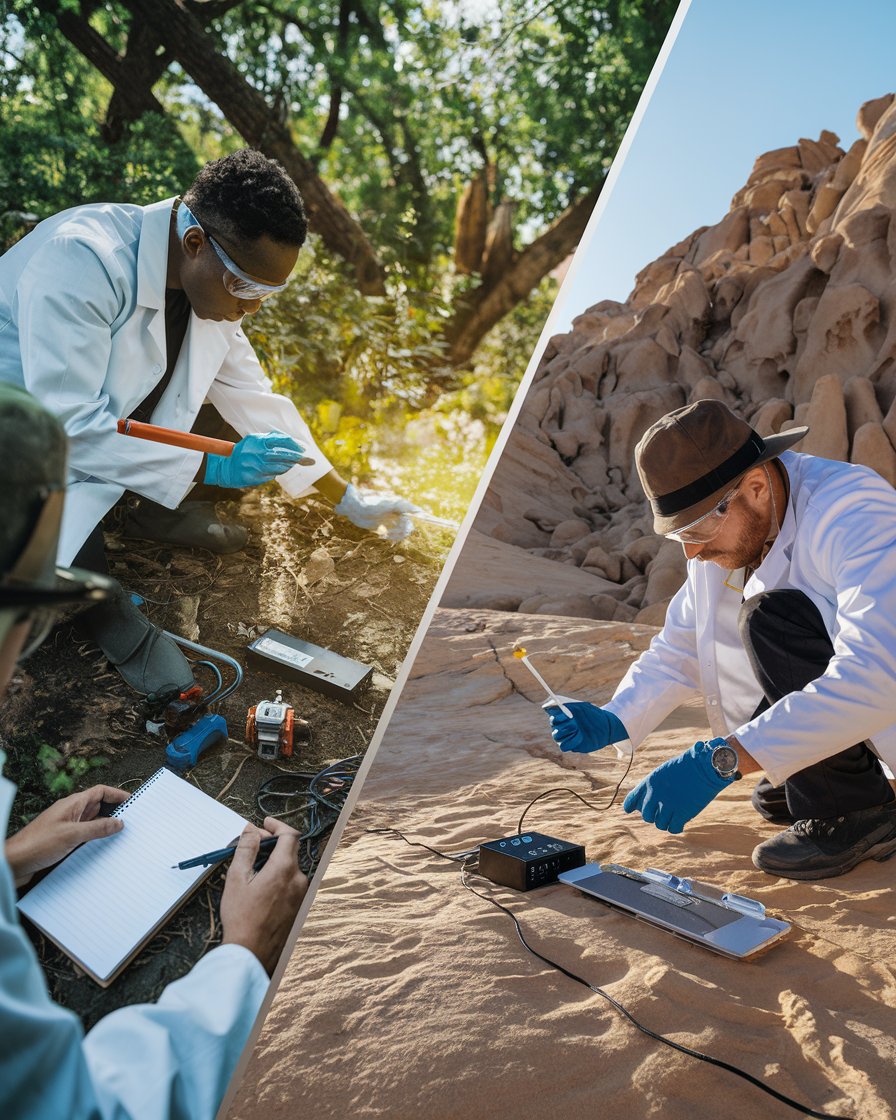Introduction
Repetition and replication are two key principles in scientific research that serve to establish the reliability and validity of findings. Repetition involves performing the same experiment multiple times to ensure consistent results, while replication requires independent scientists to replicate the process under varied conditions. This distinction helps in determining whether the results are valid or influenced by random chance. Both techniques are essential for confirming the accuracy of a scientific process and contribute to the overall credibility of research outcomes.
When considering repetition vs. replication, it’s important to note how they address different stages of the experimental process. Repetition strengthens internal consistency, while replication tests external conditions to see how universal the findings are. Whether in fields like psychology or broader scientific research, using these methods helps ensure that results can be generalized beyond a single session or trial, establishing robust conclusions that are not limited to one specific instance.
Key Takeaways
- Repetition ensures consistent results by conducting the same experiment multiple times under identical conditions, strengthening internal validity.
- Replication involves testing the experiment under different conditions or with different scientists to assess the generalizability and external validity of the findings.
- External validity is crucial in determining whether results can be applied universally, ensuring that the findings are not limited to a single scenario or population.
- Abstract concepts such as reliability and consistency guide the repetition process, confirming that outcomes are not influenced by random errors.
- Replication studies help identify how external factors like participant variability or environment impact the results, supporting the credibility of scientific research.
- Repetition vs. replication differentiates how each process contributes to validating results: repetition tests reliability, while replication ensures broader scientific credibility.
Understanding Repetition and Replication in Scientific Experiments
Repetition and replication are crucial concepts in scientific research, helping to validate findings and ensure their reliability. Repetition involves performing the same experiment multiple times to check for consistent results, while replication requires separate scientists to replicate the process under different conditions to explore variations. Both techniques contribute to the overall statistical validity of the research, with repetition focusing on internal consistency and replication testing external validity across different contexts. By comparing these processes, scientists can perform an analysis to assess whether the results are due to random chance or a reliable scientific phenomenon. Reproduction of findings through repetition and replication form the backbone of credible, robust research, providing a foundation for advancing scientific knowledge. This ensures that experiments are complete and ready for submission in the scientific community.
What is Repetition vs Replication in Science Principle
1. Repetition Strengthens Internal Validity
Repetition involves conducting the same experiment multiple times under identical conditions to ensure the consistency of results. This method reduces the likelihood of random errors and strengthens the internal validity of the research. By repeating trials, researchers can confirm that the findings are reliable and reproducible, which is critical for establishing confidence in the scientific process.
2. Replication Tests External Validity
Unlike repetition, replication involves replicating the experiment in different conditions or by different scientists. This process is essential for testing the external validity of the research, as it explores whether the findings can be generalized across various environments, populations, or methodologies. Successful replication confirms that the results are not limited to a specific trial or circumstance.
3. Repetition Focuses on Consistency
The main goal of repetition is to ensure that the experiment yields the same results each time it is conducted. Repetition plays a vital role in verifying that the procedures and measurements used in the study are reliable, minimizing the influence of external variables that might skew the data.
4. Replication Addresses Variability
Replication helps researchers understand how changes in environmental factors or participant variability may affect the experiment’s outcomes. This broader approach helps scientists determine whether the findings are universally applicable or if they only hold true under specific conditions. Replication adds depth to the research by highlighting potential variations in results when key factors are altered.
5. Repetition and Replication Together Establish Credibility
Both repetition and replication contribute to the overall credibility of scientific research. While repetition ensures that the results are reliable within the same conditions, replication tests whether the findings are valid in different settings. Together, they form a comprehensive approach to verifying the accuracy of scientific studies and expanding knowledge across various domains.
6. Repetition and Replication Inform Scientific Advancements
Repetition and replication form the foundation for advancing scientific knowledge. By continually testing and retesting findings, scientists ensure that new theories and discoveries are built on solid, reliable evidence. These processes drive progress, helping to validate and refine the principles that guide scientific research.
Repetition in Scientific Trials: Ensuring Consistency
Repetition in scientific experiments refers to repeating the exact same procedures multiple times to ensure the findings are consistent. Scientists perform repetitions to confirm that the results are not due to random factors but are reliable and reproducible. For example, a scientific hypothesis may be tested in several trials to account for variables that could affect the outcomes. Repetition strengthens the internal validity of the experiment, helping researchers to confirm that their measurements and processes are stable and reliable across various instances. This practice ensures that the scientific process remains robust and accurate.
Replication: Testing External Conditions and Variability
Replication differs from repetition in that it involves conducting the same experiment under new or altered conditions, often by different scientists or in different environments. The goal is to explore whether the original findings are robust across different settings, participant groups, or procedural variations. Replication tests the external validity of a study by assessing its applicability beyond the controlled conditions of the original research. A well-replicated experiment holds significant credibility within the scientific community, as replication confirms that the findings can be generalized and are not confined to a specific trial or condition.
How External Validity Influences Repetition and Replication
External validity plays a significant role in both repetition and replication, as it assesses whether findings can be generalized beyond the initial experiment. When experiments are repeated or replicated, external validity helps determine if the results hold true across different populations, settings, and conditions. This principle is vital for ensuring that scientific discoveries aren’t confined to one specific scenario but can apply universally. Scientists often replicate experiments in different environments, exploring how external factors, like participant variability or procedural changes, may affect the outcomes. Without external validity, repetition and replication would lack the necessary breadth to support their findings across the scientific spectrum.
Case Study: The Role of External Validity in Replicating Scientific Research
A prominent case that highlights the significance of external validity in replication comes from medical research. A pharmaceutical company conducted a clinical trial to test a new diabetes drug. Initially, the drug showed positive results in a controlled lab environment on a small sample of adults with diabetes. To confirm these findings, the researchers replicated the study across various settings, including diverse populations and geographical locations. This ensured the results were not limited to the initial study conditions. The replication validated that the drug was effective across different groups, showing that external validity was successfully established. This replication allowed the findings to be generalized to a broader population, demonstrating that the treatment could be widely applied beyond the original experimental conditions. This case emphasizes the importance of replicating studies across different settings to ensure external validity, thereby enhancing the credibility and applicability of scientific findings.
The Importance of External Validity in Generalizing Results
External validity ensures that scientific results can be applied beyond the controlled conditions of the original study. When repetition or replication is performed, external validity examines whether the findings hold true across different populations, timeframes, and contexts. For example, a study conducted in one laboratory may show consistent results, but to validate its external applicability, it needs to be replicated in different environments. External validity strengthens the generalization of scientific outcomes, showing that a phenomenon is not bound to specific instances but reflects broader scientific principles across the research spectrum.
External Factors That Affect Replication Studies
Replication studies often face challenges related to external factors, such as participant variability, environmental conditions, or procedural modifications. These external elements can significantly impact the outcome of a replication study, either confirming or disproving the original findings. Scientists consider these factors when replicating experiments to determine if they affect the reliability of the research. By accounting for external variables, researchers can identify whether the results of an experiment are a product of random chance or a valid scientific occurrence. Managing these factors ensures that replication studies maintain their credibility and contribute meaningfully to scientific discourse.
The Role of Abstract Concepts in Repetition and Replication Studies
In scientific research, abstract concepts often shape the understanding of repetition and replication. These concepts help researchers establish a coherent framework when interpreting complex phenomena. For instance, while conducting an experiment multiple times to confirm a hypothesis, scientists use abstract notions like reliability and consistency to measure the experiment’s success. Abstract thinking also plays a role in designing replication studies, where researchers replicate procedures to ensure the phenomenon is not a product of random chance. These abstract principles help scientists formulate accurate conclusions, particularly when encountering significant differences across multiple trials, contributing to the overall robustness of the study.
Reliability and Consistency: Key Abstract Concepts in Repetition
Abstract concepts such as reliability and consistency form the foundation for successful repetition in scientific studies. Reliability refers to the ability of an experiment to produce stable, repeatable results over multiple trials, while consistency emphasizes the uniformity of these results. Scientists use these abstract ideas to assess whether their findings can be trusted. For example, in psychology or neuropsychology research, repeating an experiment multiple times helps ensure that the outcomes are not influenced by random errors or biases. The reliability and consistency of an experiment provide critical insight into its validity, confirming that the procedure is sound and the results are meaningful.
Abstract Thinking in Replication: Testing Beyond the Original Study
Abstract thinking in replication involves conceptualizing broader scientific principles that go beyond the specific context of the original experiment. Replication allows scientists to test if the findings hold up in different conditions, which can lead to a deeper understanding of the phenomenon under investigation. For example, when conducting replication studies, researchers may use different methods, sample sizes, or participant groups to explore how the experiment’s results can be generalized. This type of abstract exploration helps scientists refine their theories and improve their understanding of the underlying scientific principles at play.
“Simplicity is prerequisite for reliability.” — Edsger Dijkstra
Conducting Experiments to Differentiate Repetition from Replication
The distinction between repetition and replication becomes evident when conducting experiments. While repetition involves performing the same experiment under identical conditions to ensure consistent results, replication introduces variations to assess whether the findings are applicable in different contexts. For example, a scientist might repeat a trial with the same participant group and procedures, whereas a replication study might involve different participants or settings to explore external validity. The two processes, though related, serve unique functions in the scientific process. Repetition tests the reliability of an experiment’s outcome, while replication ensures its credibility and generalizability across the scientific community.
Key Steps in Performing Repetition Studies
Performing repetition studies involves following the same experimental procedures repeatedly to confirm the consistency of the results. The aim is to see if the experiment’s outcomes remain the same when repeated under identical conditions. Key steps in repetition include ensuring all variables are controlled, measurements are accurate, and trials are conducted systematically. By adhering to these steps, scientists can ensure that any variations in results are minimized, confirming that the findings are not a result of random errors but reflect a true scientific phenomenon. Repetition is essential for building confidence in the reliability of the results.
Differentiating Replication: Testing Variability Across Conditions
Replication differs from repetition because it introduces variability into the experimental process to test the external validity of the findings. Scientists conducting replication experiments may use different methodologies, participant groups, or environmental settings to see if the results hold under these new conditions. The goal of replication is to ensure that the scientific findings are not specific to a particular trial but can be generalized to broader contexts. This process helps differentiate repetition from replication, showing that replication is designed to test the robustness and credibility of the findings in varied circumstances.
Conclusion
In conclusion, repetition and replication are fundamental techniques in scientific research that help ensure the reliability and validity of findings. Repetition allows scientists to perform the same experiment multiple times to obtain consistent results, strengthening the internal validity of the research. On the other hand, replication involves testing the experiment in varied conditions, often by different researchers, to see if the findings can be generalized across diverse contexts. Both methods are crucial for establishing the credibility of the results, ensuring that they are not influenced by random errors or specific trial conditions.
By repeating and replicating experiments, scientists can analyze the results of trials more deeply, providing insights into whether the outcomes are a true reflection of the phenomenon being studied. These methods help address any variability that may occur during the scientific process and allow researchers to validate their findings statistically. Ultimately, the combination of repetition and replication offers a comprehensive approach to ensuring that scientific discoveries are robust and reliable across different settings and trials.








